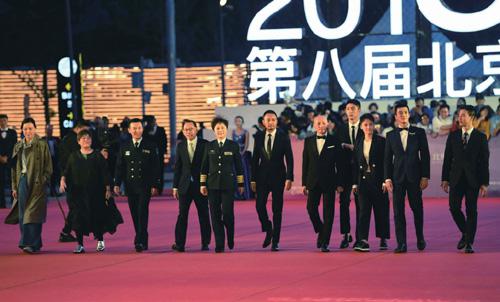Big Screen Strikes Gold
By Li Jing
The glitz and glamor of the movie industry came to the Chinese capital on April 15-22 for the Eighth Beijing International Film Festival. A total of 15 films made the cut from 659 hopefuls, spanning 71 countries and regions, all in the hunt for the top 10 awards of 2018. Scary Mother, produced in Georgia and Estonia, won Best Feature Film, while Mariam Khatchvani walked away with the Best Director award for the fi lm Dede.
While much of the dazzle centered on the film awards, recent Chinese box office figures are also something to celebrate. China has now become the worlds second largest film market. According to statistics released at the fi lm festival, a total of 970 fi lms were produced on the Chinese mainland in 2017, and the annual box office revenue reached 55.91 billion yuan($8.9 billion), up 13.45 percent year on year. Also during 2017, the number of screens on the Chinese mainland increased by 9,597 to top 50,776.
“These fi gures indicate Chinas remarkable rise in the fi lm industry,” Gao Wei, a member of the China Literature and Art Critics Association, told Beijing Review.
Box office success
After the fi lm Operation Red Sea premiered on the Chinese mainland on February 16, its box office revenue maintained a steady upward trajectory, climbing to 2.5 billion yuan ($396.8 million) that month. Toward the end of April, the revenue had exceeded 3.6 billion yuan ($571.4 million), proving to be a box offi ce hit like Wolf Warrior II, which to date has earned 5.68 billion yuan ($901.6 million) since its premiere in 2017. Both fi lms have a military theme.
In addition, other f ilms that debuted in early 2018, such as Detective Chinatown II, Monster Hunt II, and The Ex-File: The Return of the Exes,as well as some 2017 fi lms, such as Wolf Warrior II, Never Say Die and Youth, had breakthroughs at the box offi ce. Compared to previous years, when Hollywood blockbusters took most of Chinas box offi ce earnings and local fi lms were greatly criticized, the situation is changing as Chinese audiences are voting for home-grown fi lms with their wallets.
Statistics in the past 10 years from the real-time box office database website China Box Offi ce show that from 2009 to 2011, U.S. fi lms dominated the Chinese mainland market. However, since 2012, Chinese films have occupied the top position, with the exception of 2014, when Transformers: Age of Extinction took the top earnings. From January 2017 to April 2018, four of the top fi ve box offi ce earners were produced on the Chinese mainland.
Human story line
“Though Chinas fi lm industry is not as strong as some countries, it is now on the right development track as indicated by these numbers,” said Gao. “Good fi lms need to tell human stories.”
Gaos comments were echoed by Johannes Rexson, Vice Chairman of the European Producers Club. He noted that good fi lms are about humanity and should touch peoples hearts. According to him, the technical aspects of films are important, but what attracts audiences more is the “how and what” aspects of stories.
This can clearly be seen in Operation Red Sea, which was adapted from the true story of Chinese nationals being evacuated from wartorn Yemen in 2015. It tells the story of the Chinese navy marine corps saving overseas Chinese and fi ghting against terrorists.
The film depicts combat scenes in great detail. Yu Dong, President of Bona Film Group, producer of the fi lm, worried that the brutal war scenes in the fi lm would upset audiences. But his fears proved to be unfounded. “We sent the film to the navy for review, and they said the fi lm refl ects the real situation of the operation and could even encourage Chinese navy troops in future operations,” said Yu.
“Actually, a factual story line, vivid scenes and the human touch are the major factors that made Operation Red Sea a great success,” said Huang Huilin, Vice Chairwoman of the China Literature and Art Critics Association, citing Wolf Warrior II as another example.
She noted that she has personally experienced the improvement of Chinese film quality in recent years, and the reason is that they are “focusing on the content and the audience” more.
The development of filmmaking technology is another engine driving the growth of the Chinese fi lm market. In fi lms such as Operation Red Sea and Wolf Warrior II, it is of great importance to have high-quality film props and advanced special effects and post-production in order to refl ect real war scenes. When shooting Operation Red Sea for example, real guns and bullets were used to ensure the right effect. According to director Dante Lam from Hong Kong, the $100-million budget was mainly used for special effects and post-production, including more than $30 million in military equipment.
Moreover, the improvement of fi lm projecting facilities in China has attracted audiences to cinemas. At the end of 2017, China had 288 IMAX cinemas in operation in more than 140 cities that served more than 16 million people throughout the year. At the same time, more than 6,000 sets of ALPD (Advanced Laser Phosphor Display) were installed in cinemas, accounting for 80 percent of the laser projection market.
Global audience
Despite Chinas fi lm success, the majority of box office revenue is from domestic and overseas Chinese audiences. Experts point out that in future development, China should seek cooperation with countries and regions with sound fi lmmaking experience to promote its fi lms on the international market for wider recognition. Cross-border cooperation and cross-cultural films were hot topics at the Sino-Foreign Film Co-Production Forum during this years Beijing f ilm festival.
According to U.S. f ilm director Rob Minkoff, a good f ilm should touch the innermost emotions of a global audience in terms of story selection and story-telling methods. He said although people have different cultures and vary in educational backgrounds, they all have something in common deep in their hearts: their humanity. He cited the Pixar animated fi lm Coco as an example of how a good fi lm can go beyond cultural differences and touch the soul of many people.
“Chinese audiences loved Coco. But few of them really understand Mexican culture. The fi lm is about death; the story takes place after a loved one dies. This is similar to Chinese traditional culture,” he explained.
Wang Zhonglei, co-founder and CEO of Huayi Brothers Media Corp., a Chinese multinational entertainment company, said efforts should be made to break through the existing model of China-foreign cooperation in film production.
“We need an all-process cooperation with foreign countries, from story planning to film distribution, and not just a focus on investment and content,” he said. “We are still on the road of expanding the Chinese film industry, especially in the international market.”

